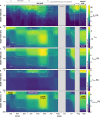Dynamic ice-ocean pathways along the Transpolar Drift amplify the dispersal of Siberian matter
- PMID: 40229259
- PMCID: PMC11997031
- DOI: 10.1038/s41467-025-57881-9
Dynamic ice-ocean pathways along the Transpolar Drift amplify the dispersal of Siberian matter
Abstract
The Transpolar Drift (TPD) plays a crucial role in regulating Arctic climate and ecosystems by transporting fresh water and key substances, such as terrestrial nutrients and pollutants, from the Siberian Shelf across the Arctic Ocean to the North Atlantic. However, year-round observations of the TPD remain scarce, creating significant knowledge gaps regarding the influence of sea ice drift and ocean surface circulation on the transport pathways of Siberian fresh water and associated matter. Using geochemical provenance tracer data collected over a complete seasonal cycle, our study reveals substantial spatiotemporal variability in the dispersal pathways of Siberian matter along the TPD. This variability reflects dynamic shifts in contributions of individual Siberian rivers as they integrate into a large-scale current system, followed by their rapid and extensive redistribution through a combination of seasonal ice-ocean exchanges and divergent ice drift. These findings emphasize the complexity of Arctic ice-ocean transport pathways and highlight the challenges of forecasting their dynamics in light of anticipated changes in sea ice extent, river discharge, and surface circulation patterns.
© 2025. The Author(s).
Conflict of interest statement
Competing interests: The authors declare no competing interests.
Figures







Similar articles
-
Separating individual contributions of major Siberian rivers in the Transpolar Drift of the Arctic Ocean.Sci Rep. 2021 Apr 15;11(1):8216. doi: 10.1038/s41598-021-86948-y. Sci Rep. 2021. PMID: 33859225 Free PMC article.
-
Arctic warming interrupts the Transpolar Drift and affects long-range transport of sea ice and ice-rafted matter.Sci Rep. 2019 Apr 2;9(1):5459. doi: 10.1038/s41598-019-41456-y. Sci Rep. 2019. PMID: 30940829 Free PMC article.
-
The Transpolar Drift conveys methane from the Siberian Shelf to the central Arctic Ocean.Sci Rep. 2018 Mar 14;8(1):4515. doi: 10.1038/s41598-018-22801-z. Sci Rep. 2018. PMID: 29540806 Free PMC article.
-
Arctic climatechange and its impacts on the ecology of the North Atlantic.Ecology. 2008 Nov;89(11 Suppl):S24-38. doi: 10.1890/07-0550.1. Ecology. 2008. PMID: 19097482 Review.
-
Recent climate change in the Arctic and its impact on contaminant pathways and interpretation of temporal trend data.Sci Total Environ. 2005 Apr 15;342(1-3):5-86. doi: 10.1016/j.scitotenv.2004.12.059. Epub 2005 Mar 19. Sci Total Environ. 2005. PMID: 15866268 Review.
References
-
- Carmack, E. C. et al. Freshwater and its role in the Arctic Marine System: Sources, disposition, storage, export, and physical and biogeochemical consequences in the Arctic and global oceans. J. Geophys. Res. Biogeosci.121, 675–717 (2016).
-
- Morison, J. et al. Changing Arctic Ocean freshwater pathways. Nature481, 66–70 (2012). - PubMed
-
- Pfirman, S. L. et al. Potential for rapid transport of contaminants from the Kara Sea. Sci. Total Environ.202, 111–122 (1997). - PubMed
-
- Rigor, I. G. & Colony, R. L. Sea-ice production and transport of pollutants in the Laptev Sea. Sci. Total Environ.202, 89–110 (1997). - PubMed
Grants and funding
- 39291/Canada First Research Excellence Fund (Fonds d'excellence en recherche Apogée Canada)
- 101023769/EC | Horizon 2020 Framework Programme (EU Framework Programme for Research and Innovation H2020)
- BA 1689/4-1/Deutsche Forschungsgemeinschaft (German Research Foundation)
- NE/R012865/1/Research Councils UK (RCUK)
- NE/R012865/2/Research Councils UK (RCUK)
- NE/R012865/1/Research Councils UK (RCUK)
- NE/R012865/2/Research Councils UK (RCUK)
- #03V01461/Bundesministerium für Bildung und Forschung (Federal Ministry of Education and Research)
- #03F0804A/Bundesministerium für Bildung und Forschung (Federal Ministry of Education and Research)
- #03V01461/Bundesministerium für Bildung und Forschung (Federal Ministry of Education and Research)
- #03F0804A/Bundesministerium für Bildung und Forschung (Federal Ministry of Education and Research)
- 1821900/National Science Foundation (NSF)
LinkOut - more resources
Full Text Sources

